Two-tone siding transforms ordinary home exteriors into striking architectural statements that boost curb appeal and property value. This design approach combines contrasting colors, textures, and materials to highlight architectural features while creating visual depth and interest. Whether you prefer subtle neutral combinations or bold dramatic contrasts, two-tone siding offers endless possibilities to personalize your home's exterior. From modern farmhouse aesthetics to coastal-inspired palettes, these designs work across various architectural styles. The key lies in thoughtful color placement, proper transitions, and understanding how different materials interact to create cohesive, stunning results that reflect your personal style.

1. Classic Farmhouse Black and White Siding

Embracing timeless charm, this design pairs crisp white horizontal lap siding with dramatic black vertical board and batten accents. The black sections typically highlight architectural features like gables, dormers, or entry areas, creating striking focal points against the pristine white foundation. White trim frames windows and doors, while the contrast emphasizes the home's structural lines. This combination works exceptionally well on modern farmhouse styles, where the dark accents add contemporary sophistication to traditional forms. The high-contrast pairing ensures your home stands out in any neighborhood while maintaining classic appeal that never goes out of style.
2. Coastal Blue and Cream Horizontal Lap Design
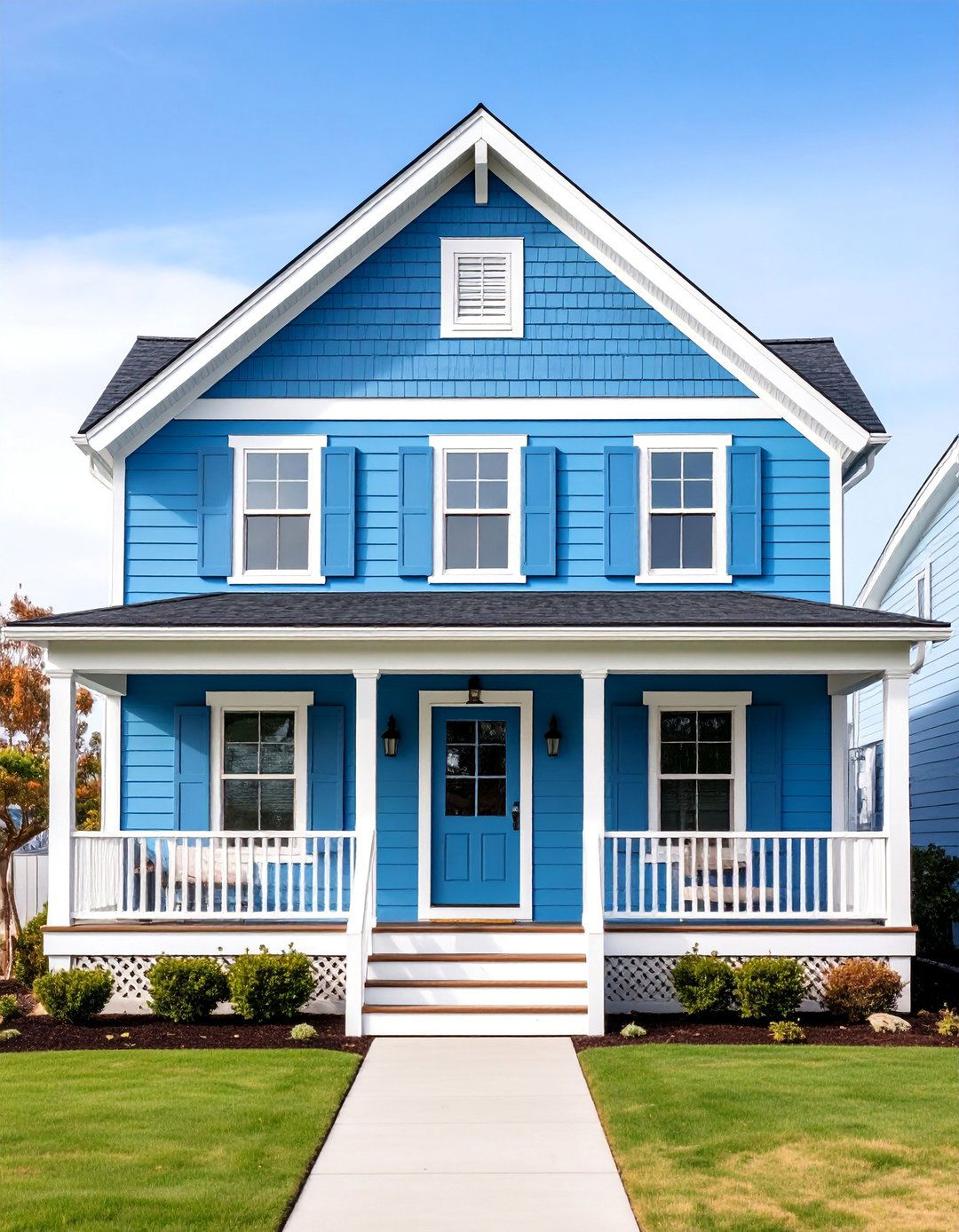
Inspired by seaside living, this soothing combination features soft coastal blue siding on upper sections with warm cream tones below. The horizontal lap installation creates clean lines that complement the color transition, typically divided at the first-floor ceiling line. White trim brightens the overall appearance while crisp window shutters in deeper blue add depth. This design evokes feelings of calm and serenity, perfect for homes near water or those wanting to capture coastal vibes. The gentle contrast between blue and cream creates visual interest without overwhelming the landscape, making it ideal for traditional Cape Cod or cottage-style architecture.
3. Modern Charcoal and Light Gray Vertical Accent
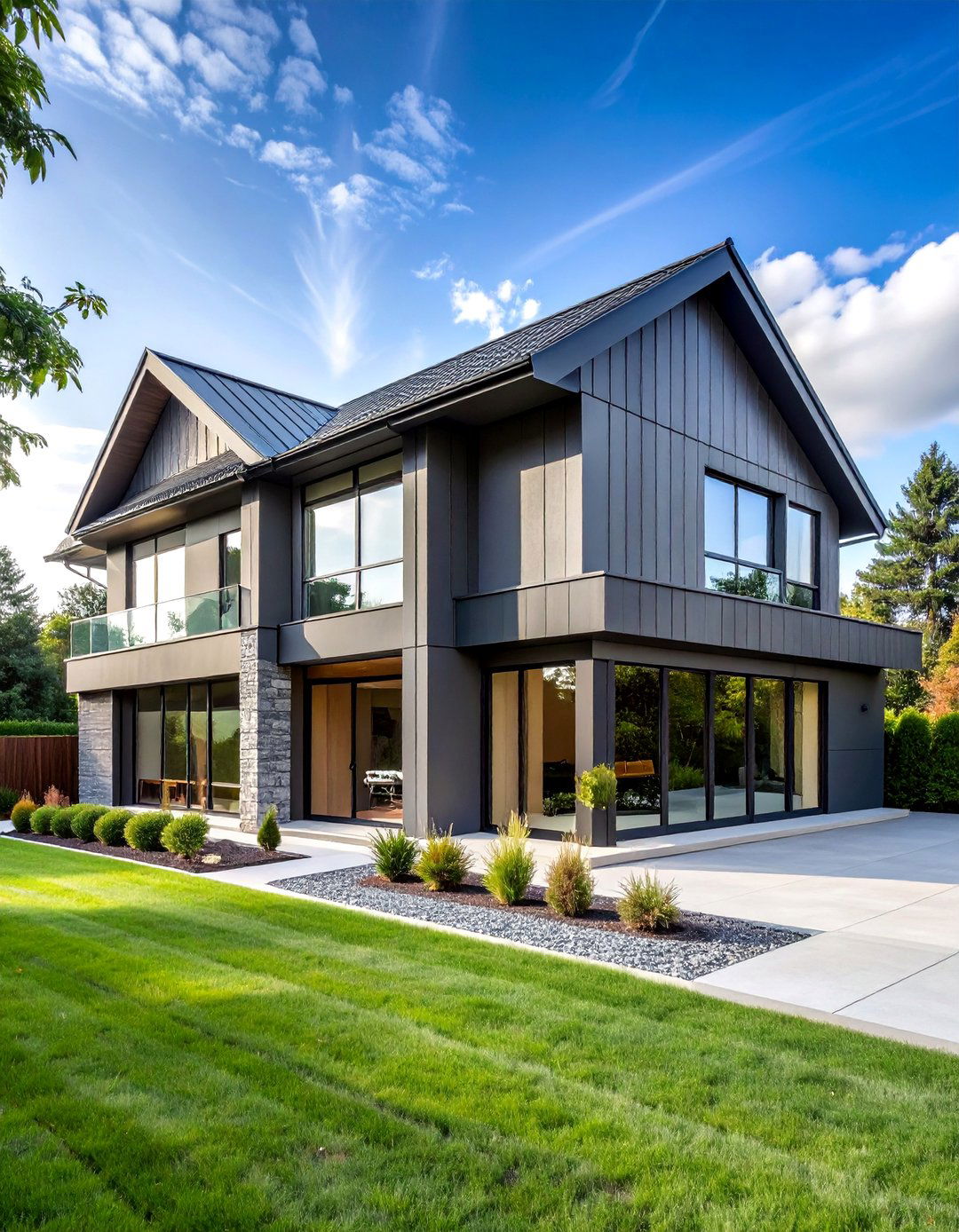
Contemporary homes benefit from this sophisticated pairing of charcoal gray main siding with light gray vertical accents. The vertical elements highlight specific architectural features like entryways, garage sections, or second-story elements, creating dynamic visual movement. This monochromatic approach uses texture and direction changes rather than dramatic color shifts to achieve impact. Metal roofing and black window frames complement the gray palette perfectly. The design works particularly well on modern ranch homes or contemporary two-story structures where clean lines and minimalist aesthetics are priorities. This combination offers timeless appeal while maintaining current design relevance.
4. Sage Green and Natural Wood Combination

Natural harmony defines this design featuring sage green fiber cement siding paired with natural wood vertical accents. The wood elements typically appear on gables, entryways, or bump-out sections, creating warm focal points against the muted green backdrop. This combination celebrates organic materials while providing weather-resistant durability where needed. Stone foundations or natural landscaping enhance the earth-tone palette beautifully. The sage green connects the home to natural surroundings while wood accents add texture and warmth. This design particularly suits craftsman, rustic, or mountain home styles where blending with natural environments is essential for authentic aesthetic appeal.
5. Navy Blue and White Cape Cod Style

Traditional New England charm emerges through this classic combination of deep navy blue siding with bright white trim and accents. The navy typically covers the main body while white highlights architectural details like window frames, doors, and corner boards. Cedar shake sections in matching navy add texture variation while maintaining color consistency. This timeless pairing works beautifully on colonial, cape cod, or traditional two-story homes where historical authenticity matters. The dramatic contrast creates immediate curb appeal while red front doors or window boxes add cheerful accent touches. This design ensures your home feels both historic and perfectly maintained.
6. Warm Beige and Rich Brown Horizontal Bands

Earthy sophistication characterizes this design featuring warm beige upper siding with rich brown lower sections. The horizontal division typically occurs at the first-floor window sill line, creating natural proportions that make homes appear larger. Different siding textures between sections add visual interest while maintaining color harmony. Natural stone or brick foundations complement the warm earth tones perfectly. This combination works exceptionally well on ranch homes, split-levels, or contemporary designs where horizontal emphasis is desired. The warm palette creates inviting, approachable exteriors while the two-tone approach adds architectural detail to otherwise simple forms.
7. Forest Green and Cream Vertical Board and Batten
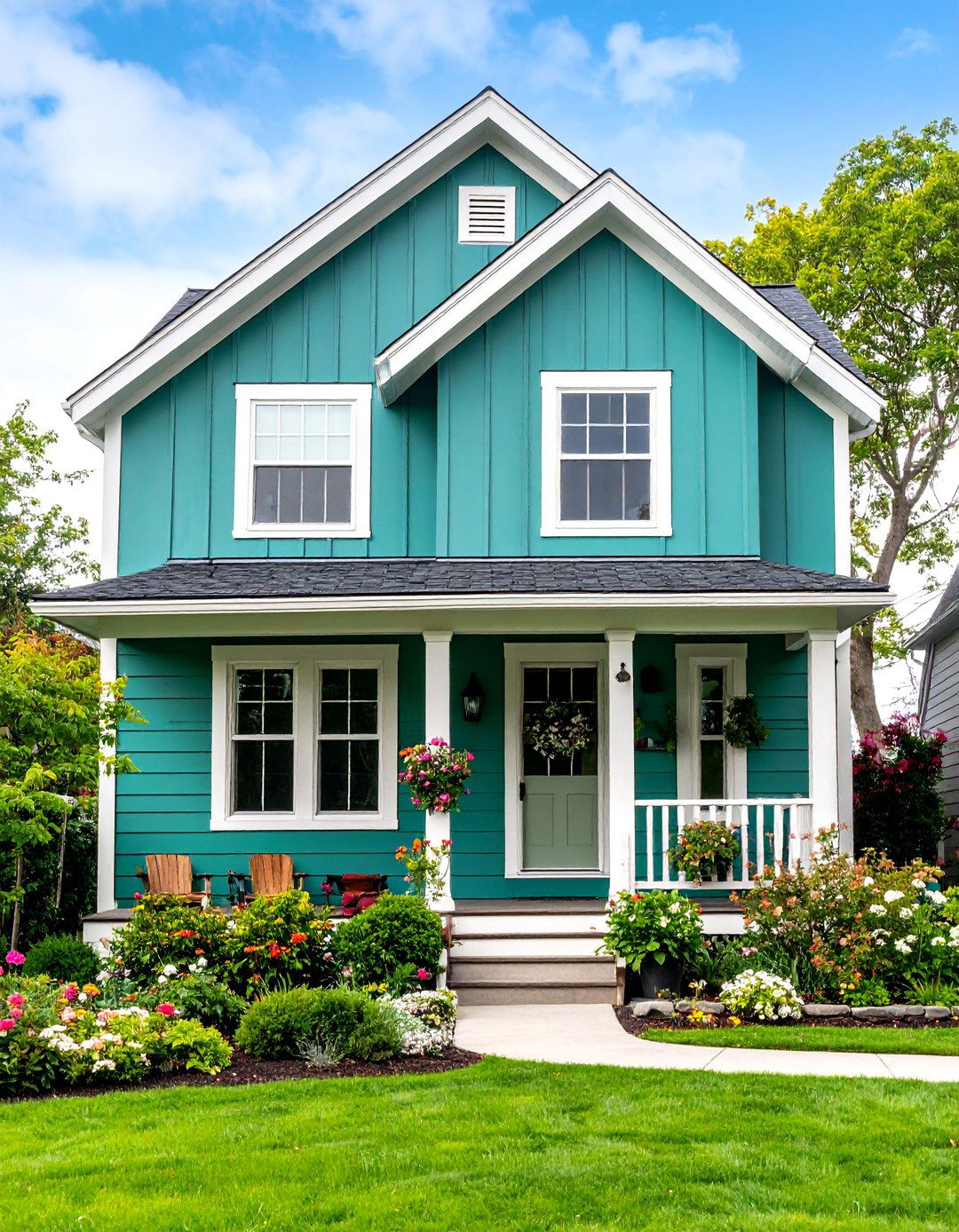
Rustic elegance defines this pairing of deep forest green vertical board and batten with cream horizontal lap siding. The vertical elements typically accent gables, entries, or specific architectural features while cream provides the primary color foundation. This combination celebrates traditional building methods while offering contemporary color sophistication. Natural wood trim in honey tones bridges the color gap beautifully. The design works particularly well on farmhouse, craftsman, or mountain home styles where connection to natural environments is important. The forest green grounds the design while cream keeps it bright and welcoming, creating perfect balance.
8. Soft Yellow and White Modern Update
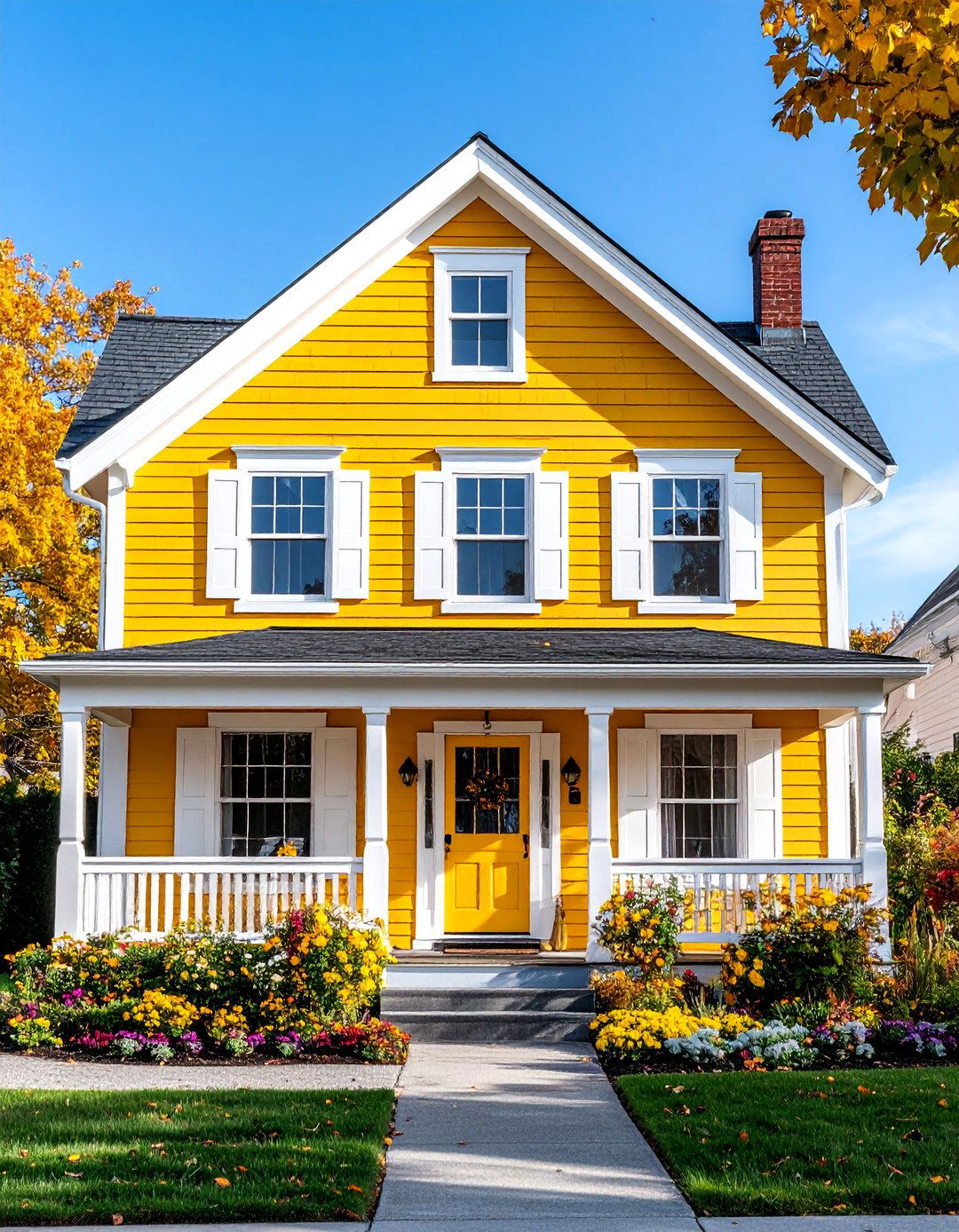
Cheerful sophistication emerges through this combination of soft buttery yellow siding with crisp white accents and trim. The yellow typically covers main wall surfaces while white highlights architectural details, creating bright, welcoming exteriors. Vertical accents in deeper yellow tones add depth without overwhelming the gentle palette. This design works beautifully on cottage, colonial, or contemporary farmhouse styles where warmth and approachability are priorities. The soft yellow reflects light beautifully, making homes appear larger and more inviting. Red or navy accent doors provide perfect color complements while maintaining the cheerful, optimistic character this combination naturally creates.
9. Pewter Gray and White Contemporary Contrast
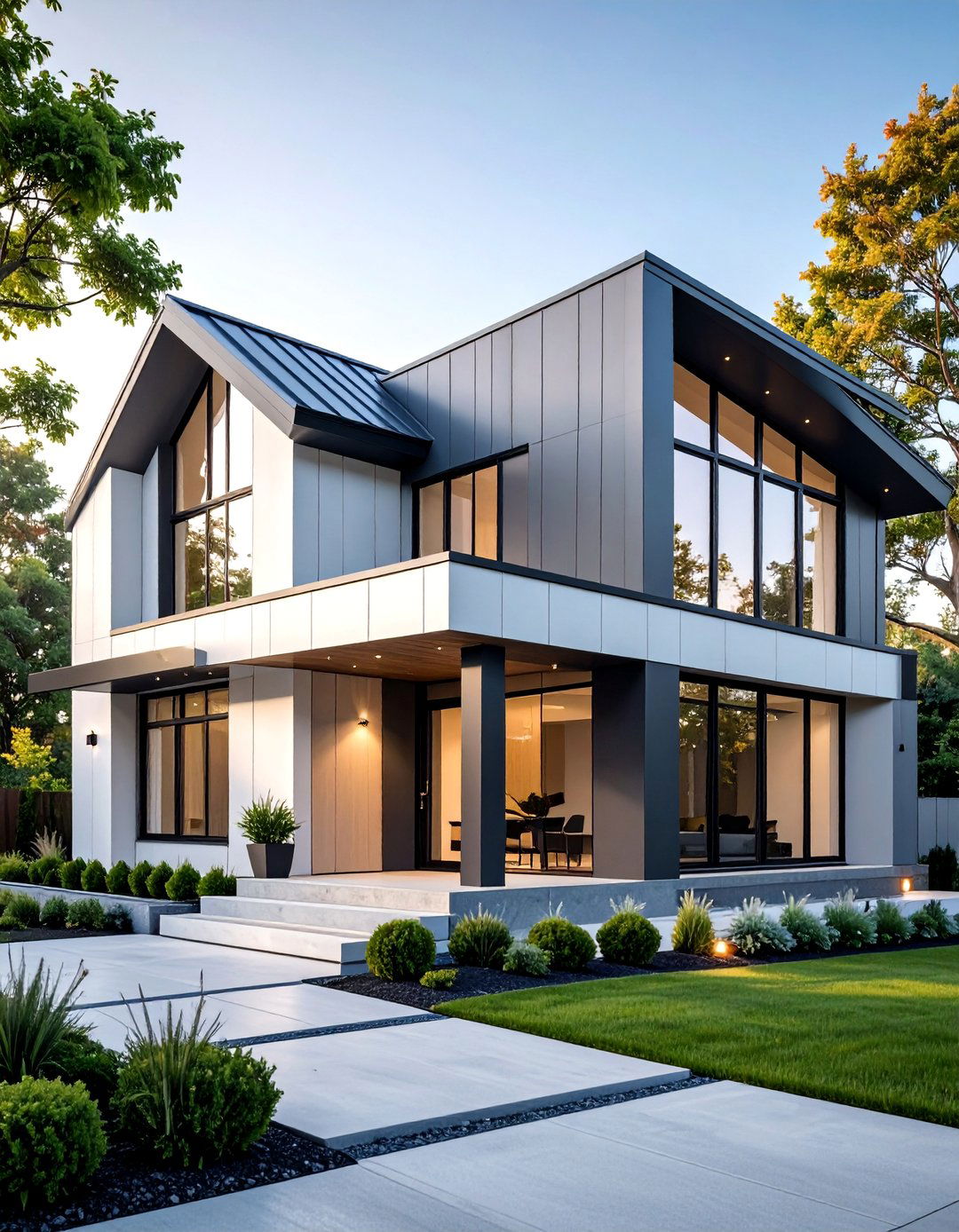
Modern minimalism meets classic elegance in this sophisticated pairing of pewter gray siding with bright white vertical accents. The white sections typically highlight specific architectural features like entries, bump-outs, or upper-level elements, creating clean geometric contrasts. Metal roofing and black window frames enhance the contemporary aesthetic perfectly. This combination works exceptionally well on modern farmhouse, contemporary, or transitional home styles where understated sophistication is desired. The neutral palette allows landscape elements and architectural details to shine while maintaining visual interest through material and directional changes rather than dramatic color contrasts.
10. Deep Red and Cream Farmhouse Appeal
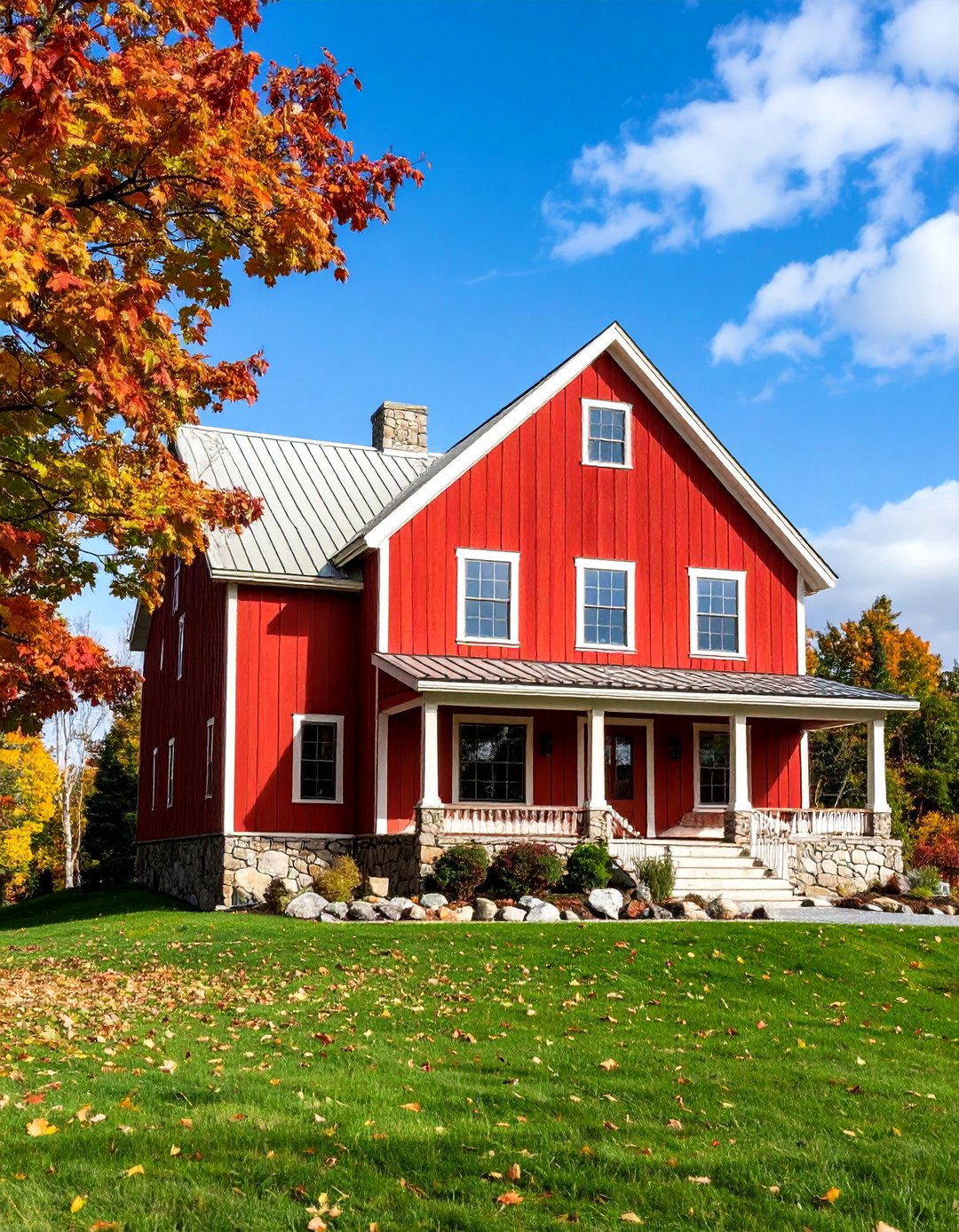
Bold traditional charm characterizes this striking combination of deep barn red siding with soft cream accents. The red typically dominates while cream highlights trim, doors, and specific architectural features like gables or dormers. Natural stone foundations or wood elements enhance the rustic appeal beautifully. This design captures authentic farmhouse character while offering contemporary color sophistication. The dramatic contrast creates immediate visual impact while maintaining warm, welcoming appeal. White window trim brightens the overall appearance while black hardware adds crisp finishing touches. This combination works perfectly on country homes, farmhouse styles, or rustic contemporary designs.
11. Coastal Gray and Soft Blue Shingle Style

Relaxed seaside living inspires this gentle combination of coastal gray shingle siding with soft blue horizontal lap accents. The blue typically appears on upper levels or specific architectural features while gray provides the foundational color. This design creates subtle visual interest through both color and texture variation. White trim brightens corners and window frames while natural wood elements add warmth. The combination works beautifully on cape cod, coastal cottage, or shingle-style homes where connection to maritime environments is important. The muted palette allows natural surroundings to complement rather than compete with the home's exterior design.
12. Mocha Brown and Tan Horizontal Division
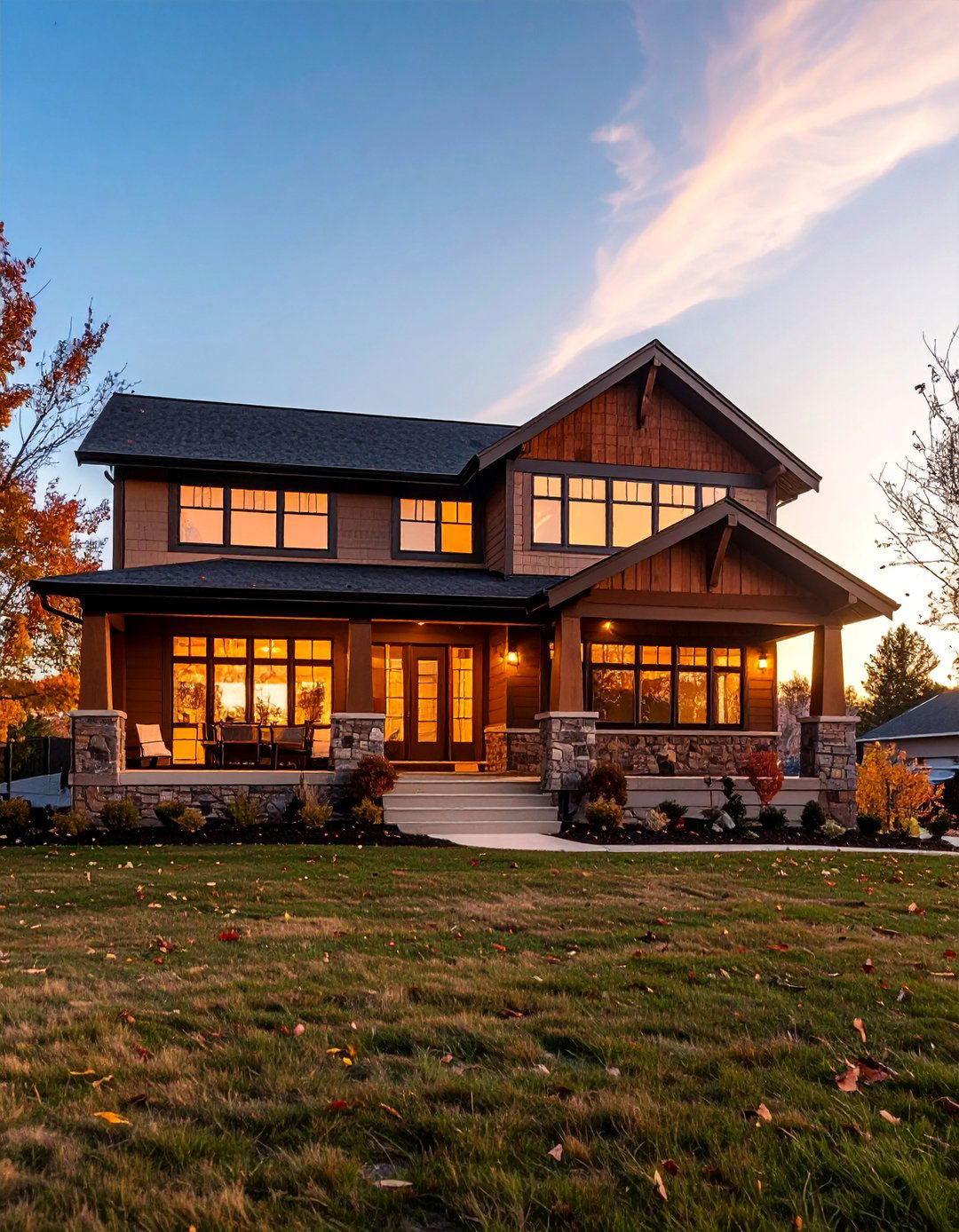
Warm earth tones define this sophisticated pairing of rich mocha brown lower siding with warm tan upper sections. The horizontal division typically occurs at the first-floor line, creating natural proportions while highlighting the home's foundation. Different textures between sections add visual interest while maintaining warm color harmony. Stone or brick accents enhance the earth-tone palette perfectly. This combination works exceptionally well on ranch, prairie, or contemporary styles where horizontal emphasis and natural material connections are desired. The warm palette creates inviting exteriors while the two-tone approach adds architectural sophistication to simple forms.
13. Slate Blue and White Vertical Accent Design
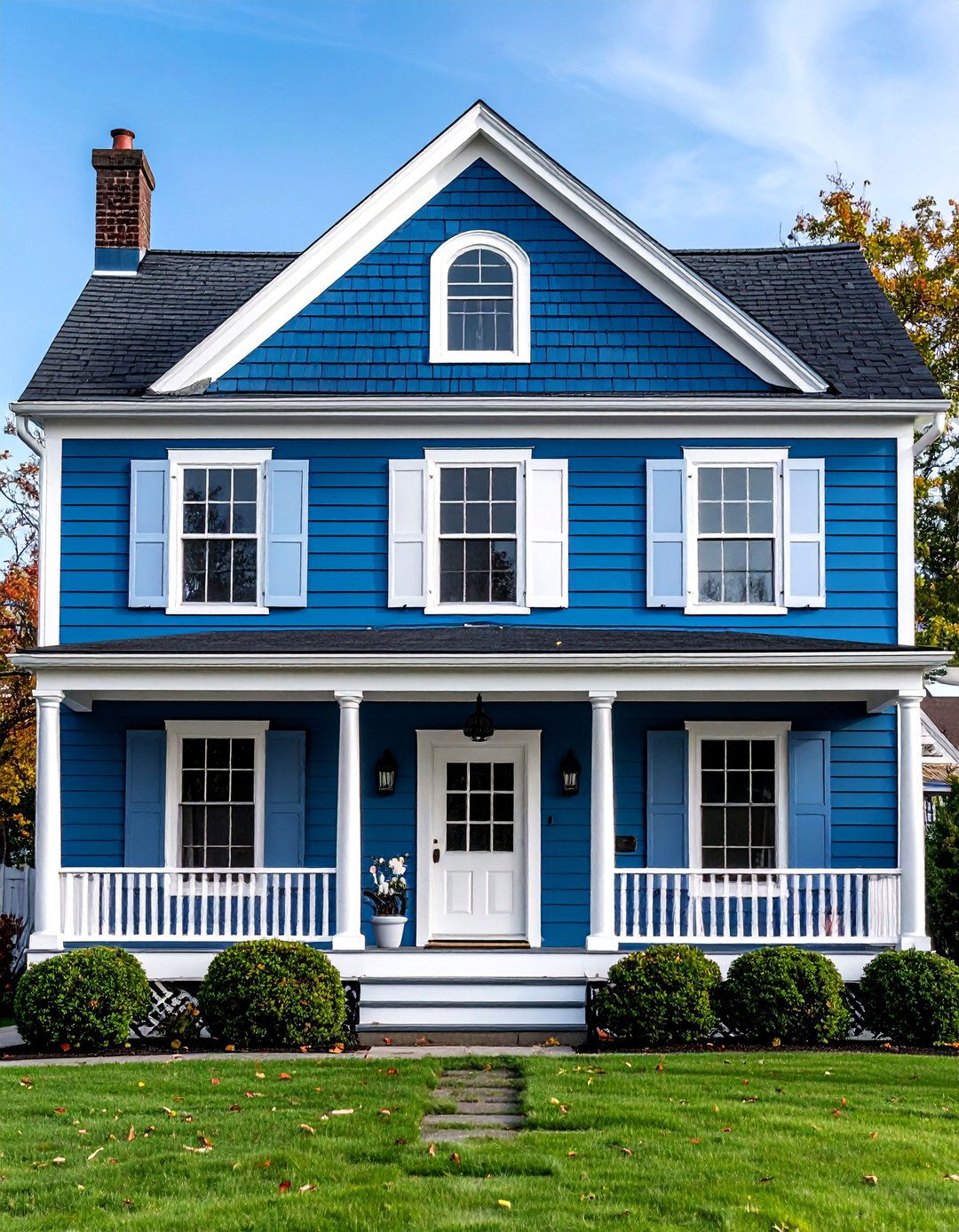
Sophisticated color meets classic detailing in this elegant combination of slate blue main siding with white vertical board and batten accents. The white sections typically highlight entries, gables, or specific architectural features, creating bright focal points against the deeper blue background. This design offers contemporary color sophistication while maintaining traditional building method references. Natural wood or stone elements enhance the refined palette beautifully. The combination works particularly well on colonial, craftsman, or contemporary farmhouse styles where both color sophistication and architectural detail are priorities. Black hardware and trim provide crisp finishing touches.
14. Olive Green and Cream Cottage Style
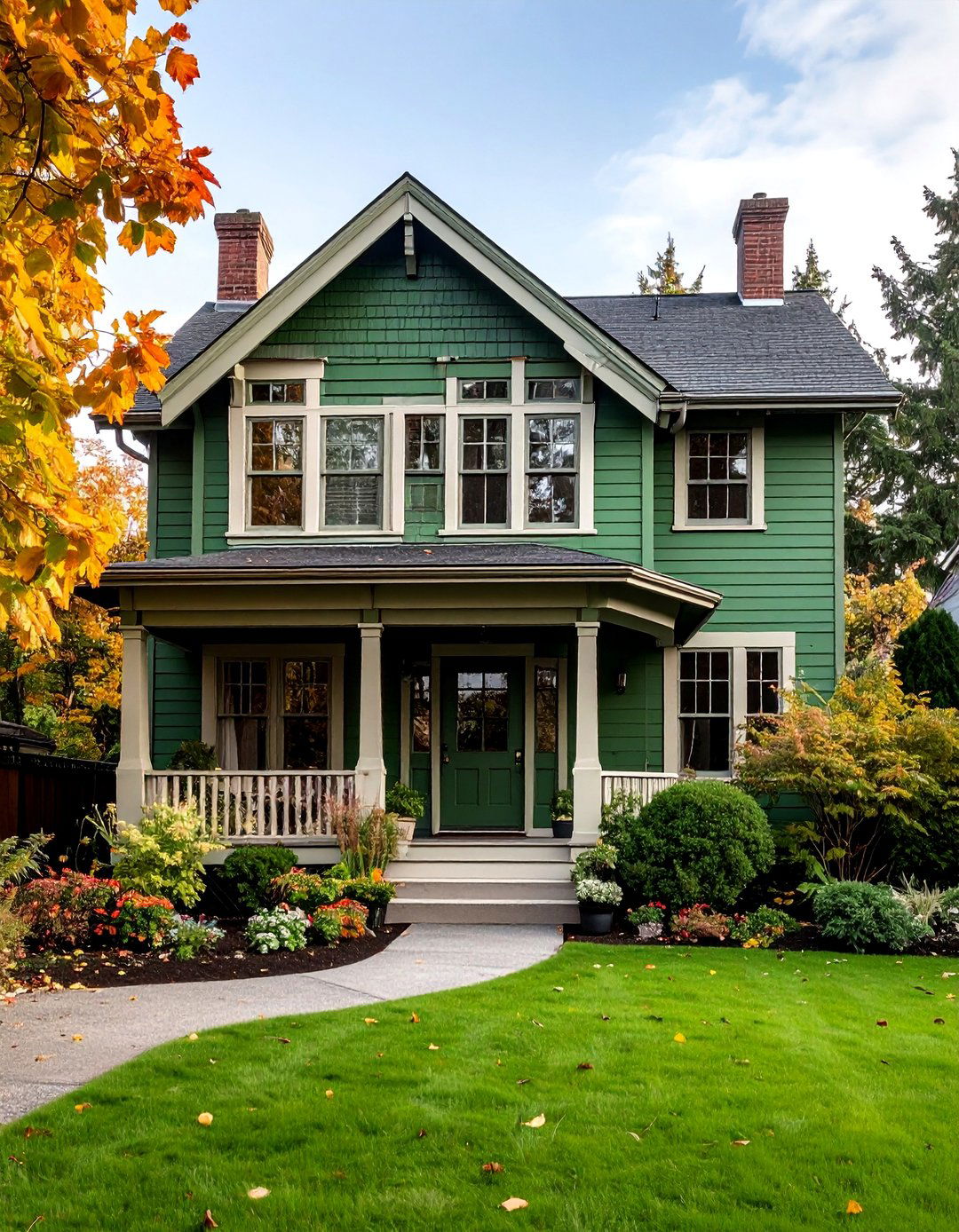
Natural serenity characterizes this soothing combination of muted olive green siding with soft cream horizontal accents. The cream typically highlights specific levels or architectural features while olive provides the primary color foundation. This design celebrates organic color palettes while offering contemporary sophistication. Natural wood trim and stone elements enhance the earth-tone appeal perfectly. The combination works beautifully on cottage, craftsman, or country home styles where connection to natural environments and gentle color palettes are priorities. White window trim brightens the overall appearance while the muted colors create calming, approachable exteriors that blend harmoniously with landscape elements.
15. Charcoal and Light Blue Modern Contrast

Contemporary sophistication defines this striking pairing of deep charcoal siding with light blue vertical accents. The blue sections typically highlight specific architectural features like entries, upper levels, or geometric elements, creating dynamic color contrasts. Metal roofing and large windows enhance the modern aesthetic perfectly. This combination works exceptionally well on contemporary, modern farmhouse, or transitional home styles where bold color statements and clean lines are priorities. The dramatic contrast creates immediate visual impact while maintaining sophisticated appeal. White trim provides crisp finishing touches while the color combination ensures the home stands out with contemporary confidence.
16. Cream and Sage Green Traditional Blend

Gentle sophistication emerges through this harmonious combination of warm cream main siding with soft sage green accents. The sage typically appears on shutters, trim, or specific architectural features while cream provides the foundational color. This design offers subtle color interest while maintaining classic appeal. Natural stone or wood elements enhance the organic palette beautifully. The combination works particularly well on colonial, cape cod, or traditional styles where gentle color sophistication and timeless appeal are priorities. The muted palette creates calming exteriors while the subtle contrast adds visual interest without overwhelming classic architectural forms.
17. Black and Natural Wood Contemporary Style
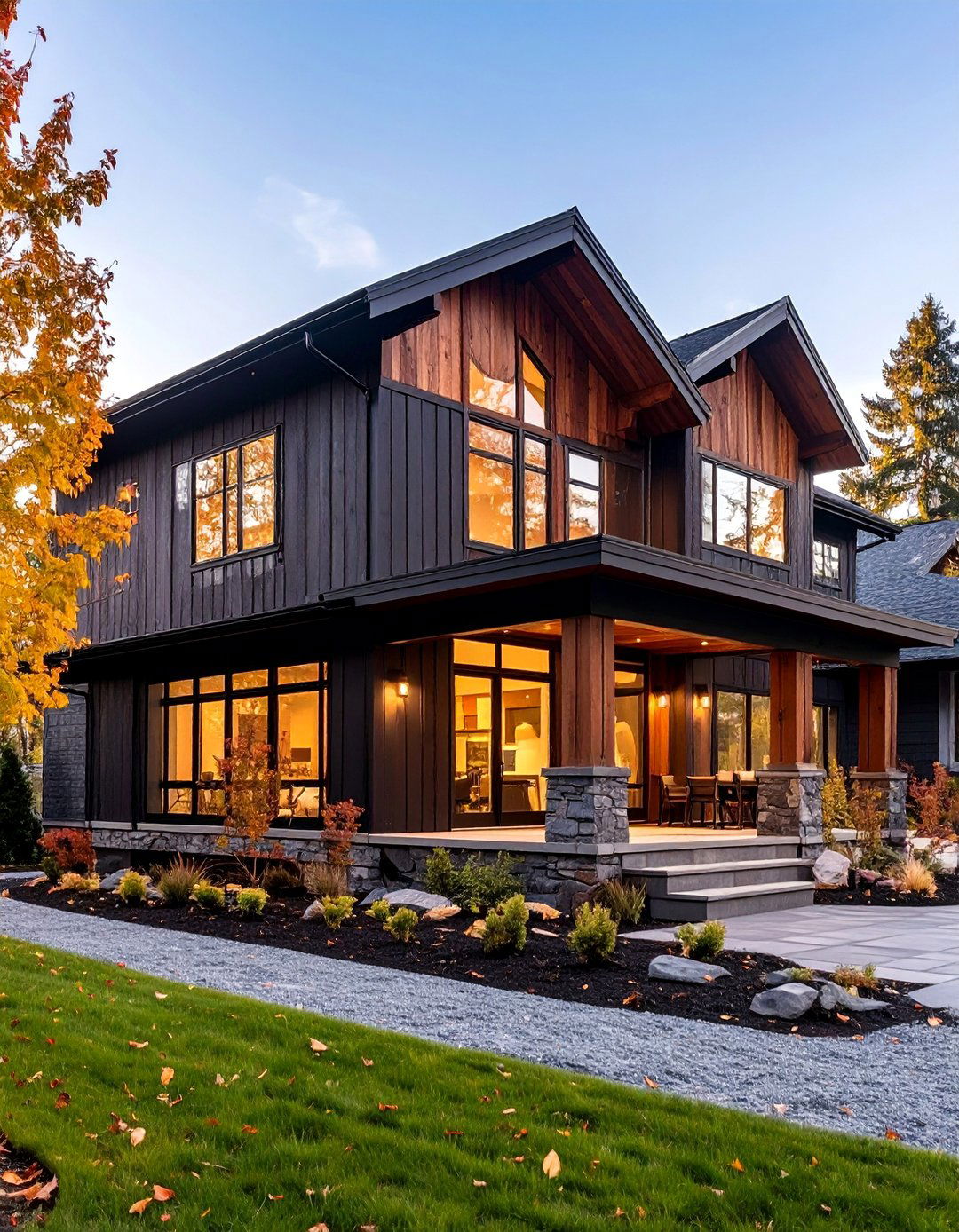
Modern rustic appeal characterizes this striking combination of black siding with natural wood vertical accents. The wood sections typically highlight entries, upper levels, or specific architectural features, creating warm focal points against the dramatic black background. This design celebrates the contrast between industrial and natural materials. Large windows and metal roofing enhance the contemporary aesthetic perfectly. The combination works exceptionally well on modern farmhouse, contemporary, or transitional styles where bold statements and material contrasts are priorities. The dramatic pairing creates immediate visual impact while maintaining sophisticated, current appeal that stands out in any neighborhood setting.
18. Soft Gray and White Board and Batten

Classic simplicity defines this elegant combination of soft gray horizontal siding with white vertical board and batten accents. The white sections typically highlight gables, entries, or upper-level elements, creating bright focal points against the gentle gray foundation. This design offers timeless appeal while maintaining contemporary relevance. Natural wood or stone elements provide texture variation beautifully. The combination works particularly well on farmhouse, colonial, or cottage styles where classic color sophistication and architectural detail are priorities. Black hardware provides crisp contrast while the neutral palette allows landscape elements and architectural features to shine without competition.
19. Burgundy and Cream Historic Appeal
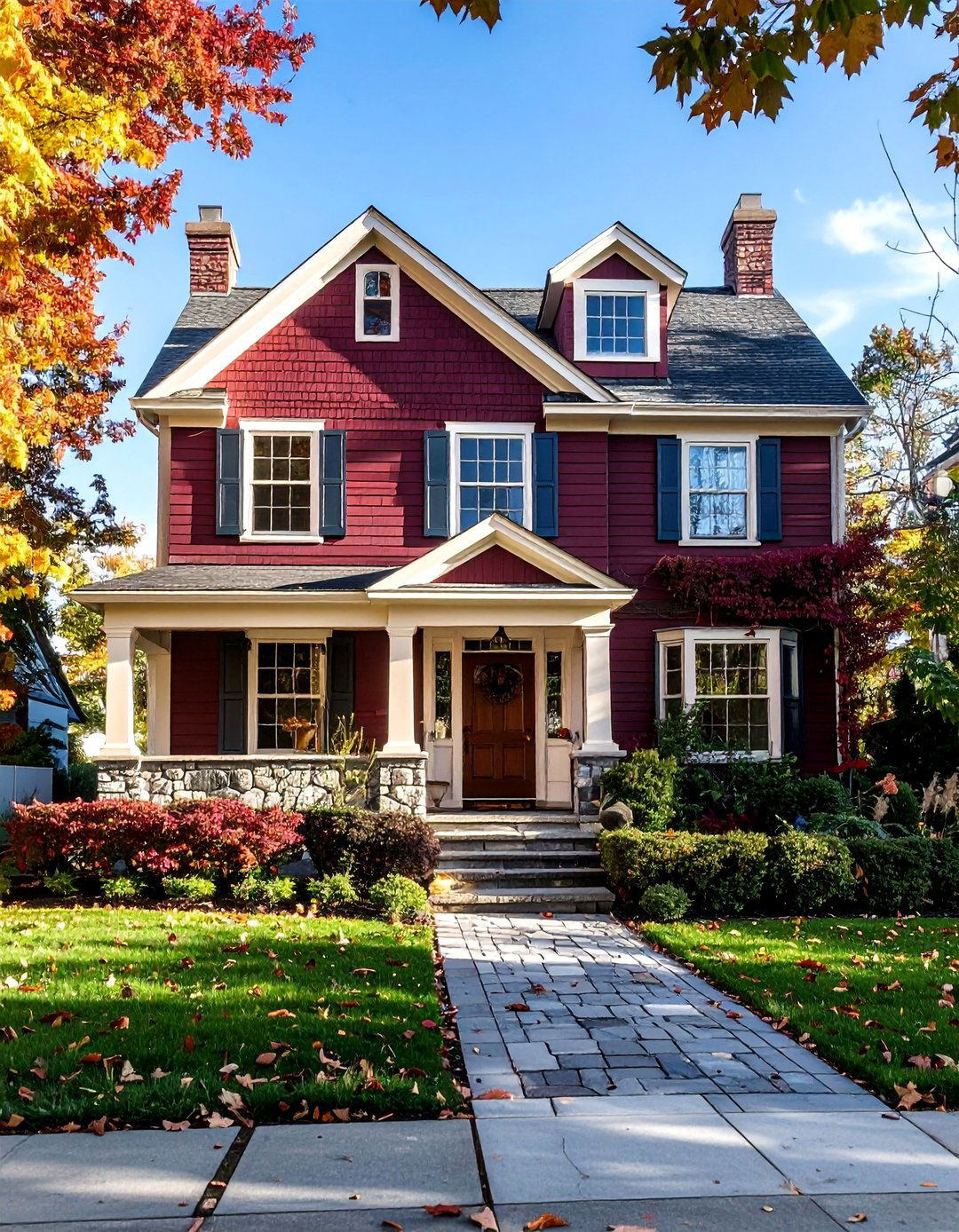
Rich traditional character emerges through this sophisticated combination of deep burgundy siding with soft cream accents and trim. The burgundy typically dominates while cream highlights architectural details like windows, doors, and corner boards. This design captures historic charm while offering contemporary color sophistication. Natural stone foundations enhance the rich palette perfectly. The combination works beautifully on colonial, victorian, or traditional styles where historic authenticity and color richness are priorities. White window trim brightens the overall appearance while brass or black hardware adds period-appropriate finishing touches. This pairing ensures homes feel both historically grounded and perfectly maintained.
20. Teal and White Coastal Modern Design
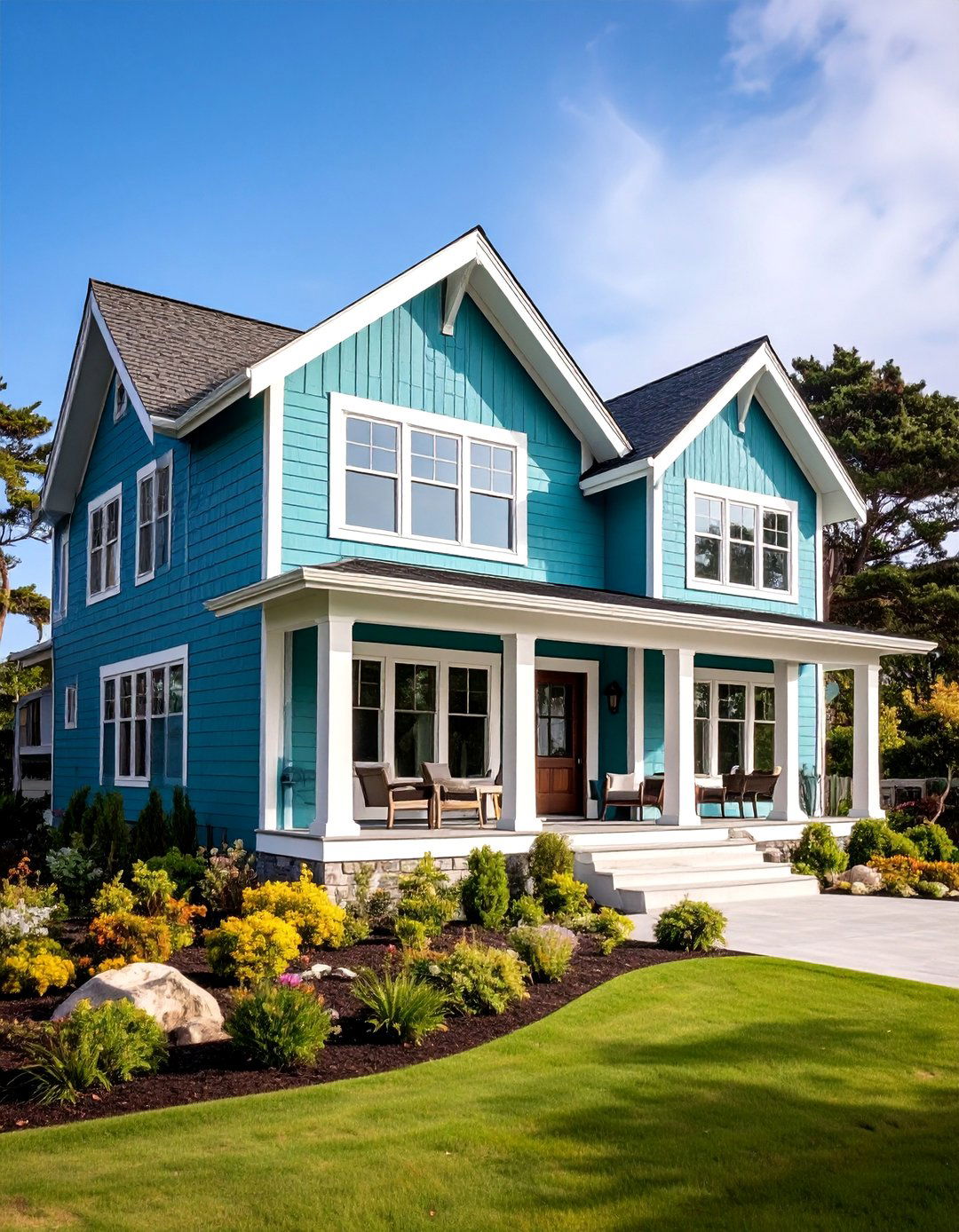
Fresh maritime inspiration characterizes this vibrant combination of rich teal siding with bright white vertical accents. The white sections typically highlight specific architectural features like entries, upper levels, or geometric elements, creating clean contrasts against the bold teal background. This design offers contemporary color excitement while maintaining coastal connections. Natural wood elements provide warm texture variation beautifully. The combination works exceptionally well on coastal cottage, modern farmhouse, or contemporary styles where bold color statements and seaside connections are priorities. The dramatic contrast creates immediate curb appeal while maintaining fresh, current aesthetic that celebrates waterfront living.
21. Taupe and Chocolate Brown Sophisticated Pairing
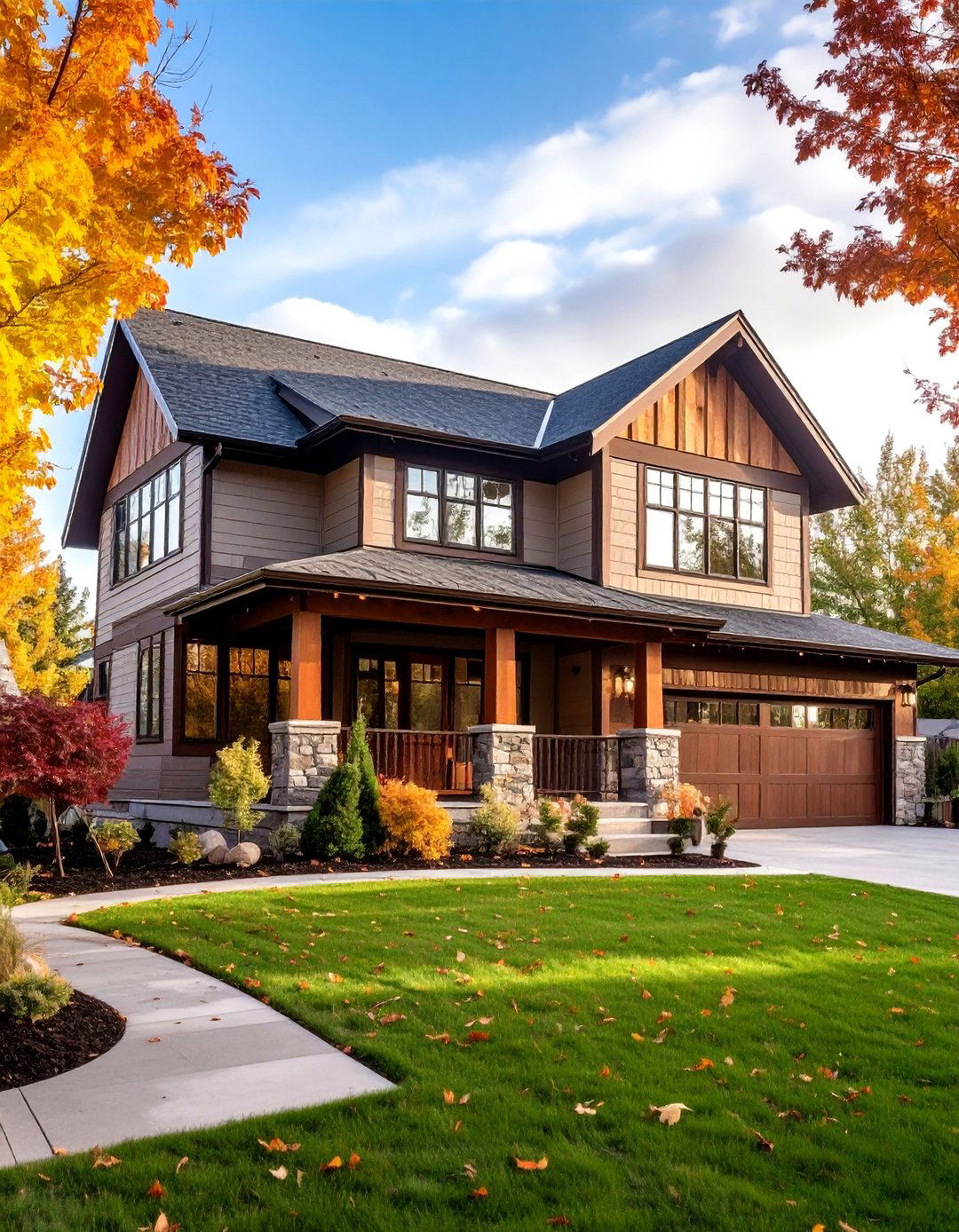
Understated elegance defines this refined combination of warm taupe main siding with rich chocolate brown accents. The brown typically appears on lower sections, trim, or specific architectural features while taupe provides the primary color foundation. This design offers sophisticated color harmony while maintaining warm appeal. Natural stone or brick elements enhance the earth-tone palette perfectly. The combination works particularly well on prairie, craftsman, or contemporary styles where subtle sophistication and natural material connections are priorities. The monochromatic approach creates calming exteriors while the subtle contrast adds depth and architectural interest to simple forms.
22. Steel Blue and Cream Vertical Contrast
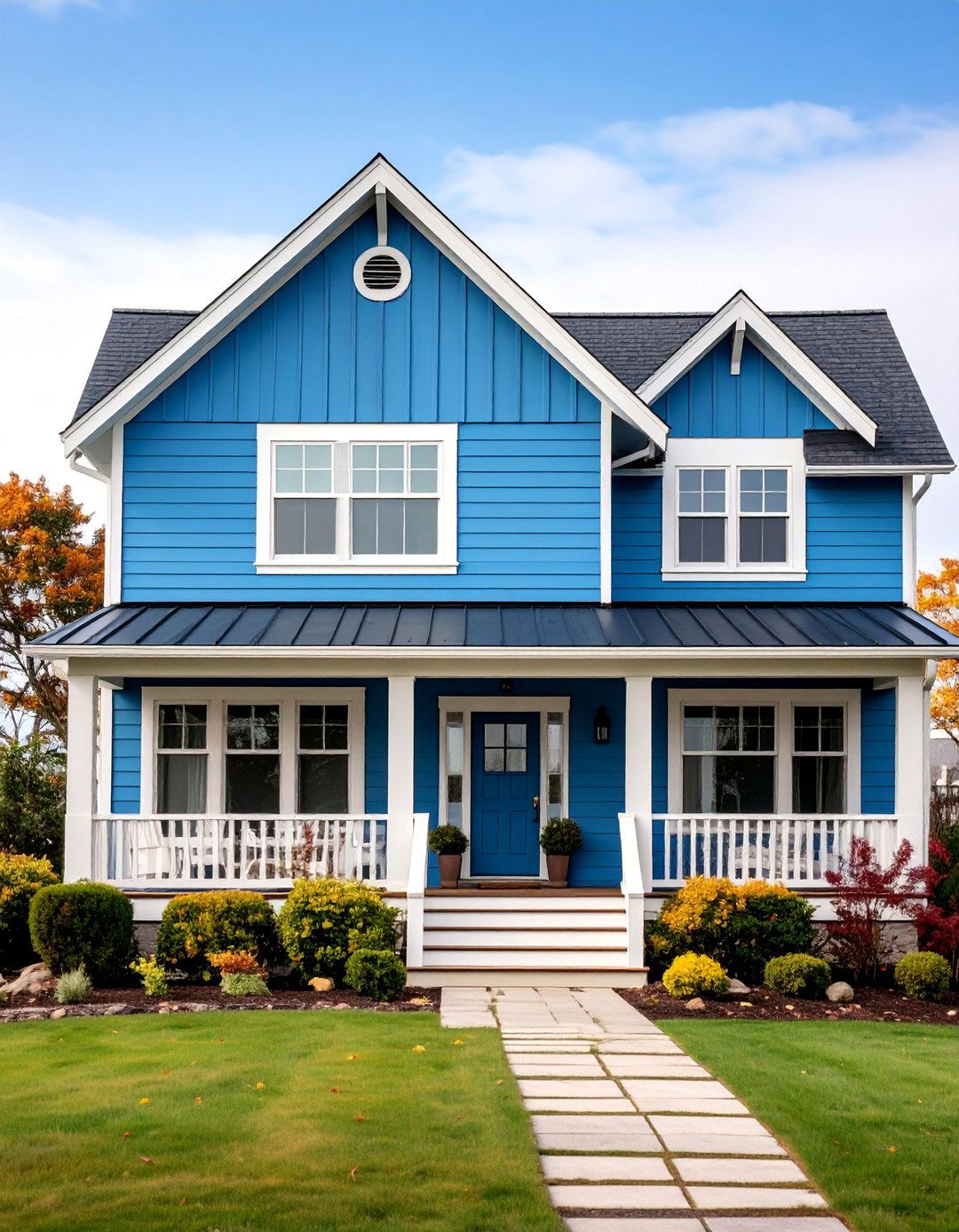
Contemporary coastal appeal emerges through this sophisticated combination of steel blue siding with cream vertical board and batten accents. The cream sections typically highlight gables, entries, or upper-level elements, creating bright focal points against the deeper blue background. This design offers modern color sophistication while maintaining traditional building method references. White trim and natural wood elements enhance the refined palette beautifully. The combination works exceptionally well on contemporary farmhouse, coastal, or transitional styles where both color sophistication and architectural detail are priorities. The pairing creates immediate visual impact while maintaining timeless appeal.
23. Forest Green and Tan Rustic Combination

Natural harmony characterizes this earthy pairing of deep forest green siding with warm tan horizontal accents. The tan typically appears on specific levels or architectural features while green provides the primary color foundation. This design celebrates organic color palettes while offering contemporary sophistication. Natural wood trim and stone elements enhance the earth-tone appeal perfectly. The combination works beautifully on mountain, craftsman, or rustic contemporary styles where connection to natural environments and organic color palettes are priorities. The muted colors create calming exteriors that blend harmoniously with wooded or natural landscape elements while maintaining architectural sophistication.
24. Soft Pink and White Cottage Charm

Gentle romance defines this charming combination of soft blush pink siding with bright white vertical accents and trim. The white sections typically highlight gables, entries, or specific architectural features, creating fresh focal points against the warm pink background. This design offers unique color character while maintaining classic appeal. Natural wood elements provide texture variation beautifully. The combination works particularly well on cottage, coastal, or victorian styles where distinctive color personality and feminine charm are priorities. The subtle pink creates welcoming exteriors while white trim provides crisp finishing touches that prevent the color from becoming overwhelming.
25. Midnight Blue and Silver Gray Modern Edge
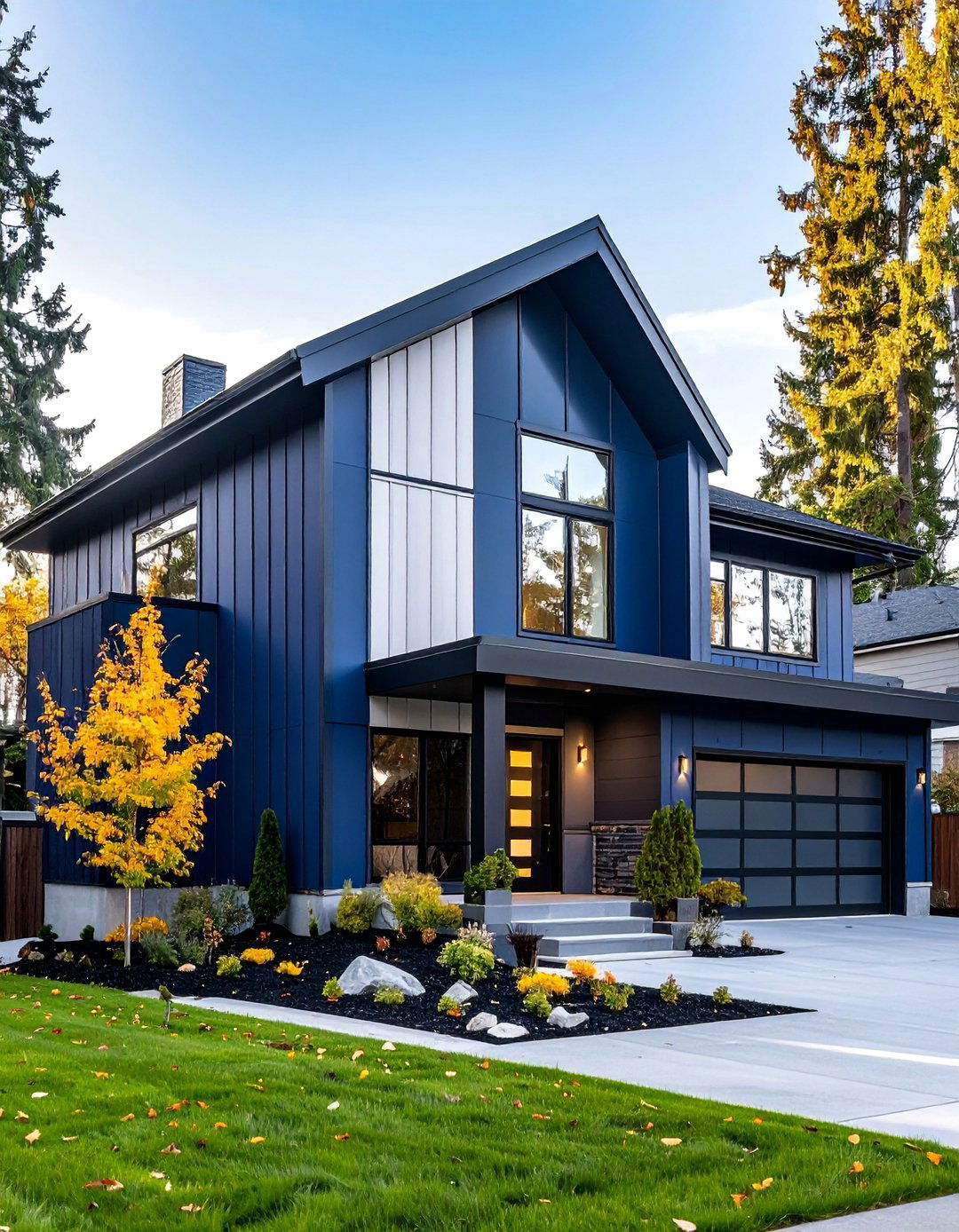
Dramatic contemporary appeal characterizes this striking combination of deep midnight blue siding with silver gray vertical accents. The gray sections typically highlight specific architectural features like entries, upper levels, or geometric elements, creating sophisticated contrasts against the rich blue background. This design offers bold color statements while maintaining current aesthetic relevance. Metal roofing and large windows enhance the modern character perfectly. The combination works exceptionally well on contemporary, modern farmhouse, or transitional styles where dramatic color impact and sophisticated appeal are priorities. The pairing creates immediate visual interest while ensuring the home stands out with confident, contemporary style.
Conclusion:
Two-tone siding designs offer homeowners exceptional opportunities to create distinctive, personalized exteriors that enhance both curb appeal and property value. These 25 design concepts demonstrate how thoughtful color combinations, strategic material placement, and attention to architectural features can transform ordinary homes into extraordinary statements. From classic farmhouse appeal to contemporary sophistication, two-tone approaches work across all architectural styles. The key lies in understanding your home's unique character, considering surrounding landscapes, and choosing combinations that reflect your personal style while maintaining timeless appeal that will look beautiful for years to come.



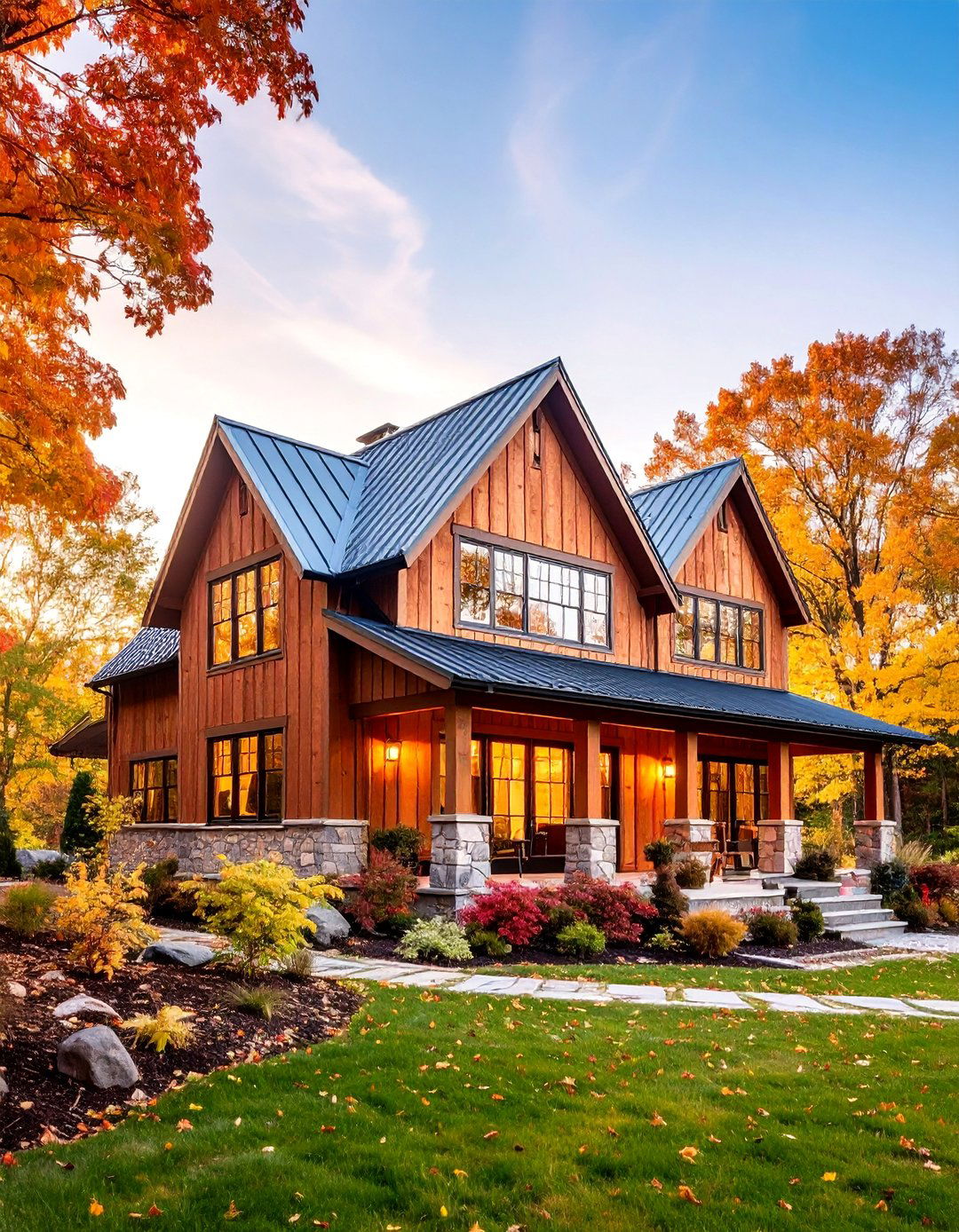





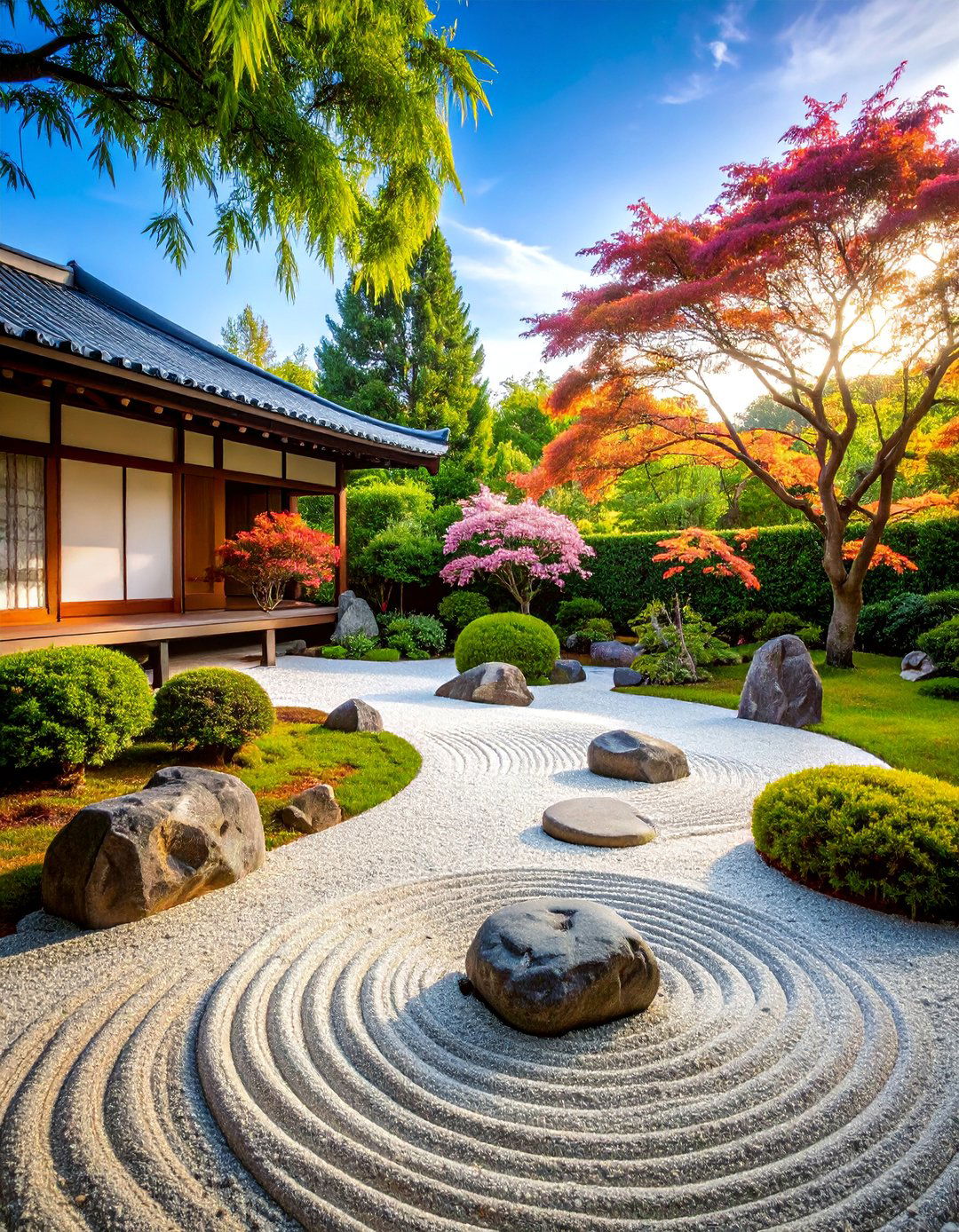


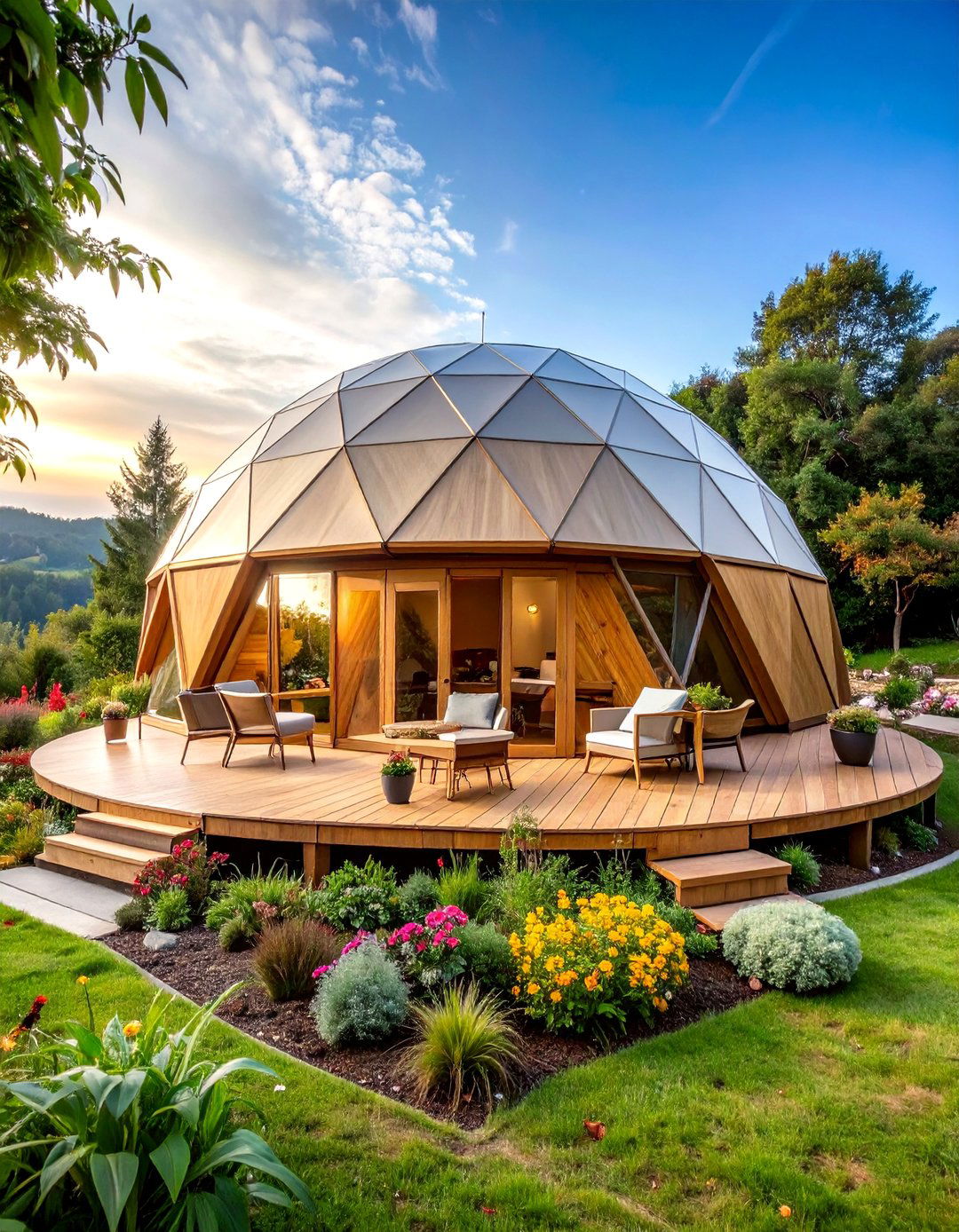
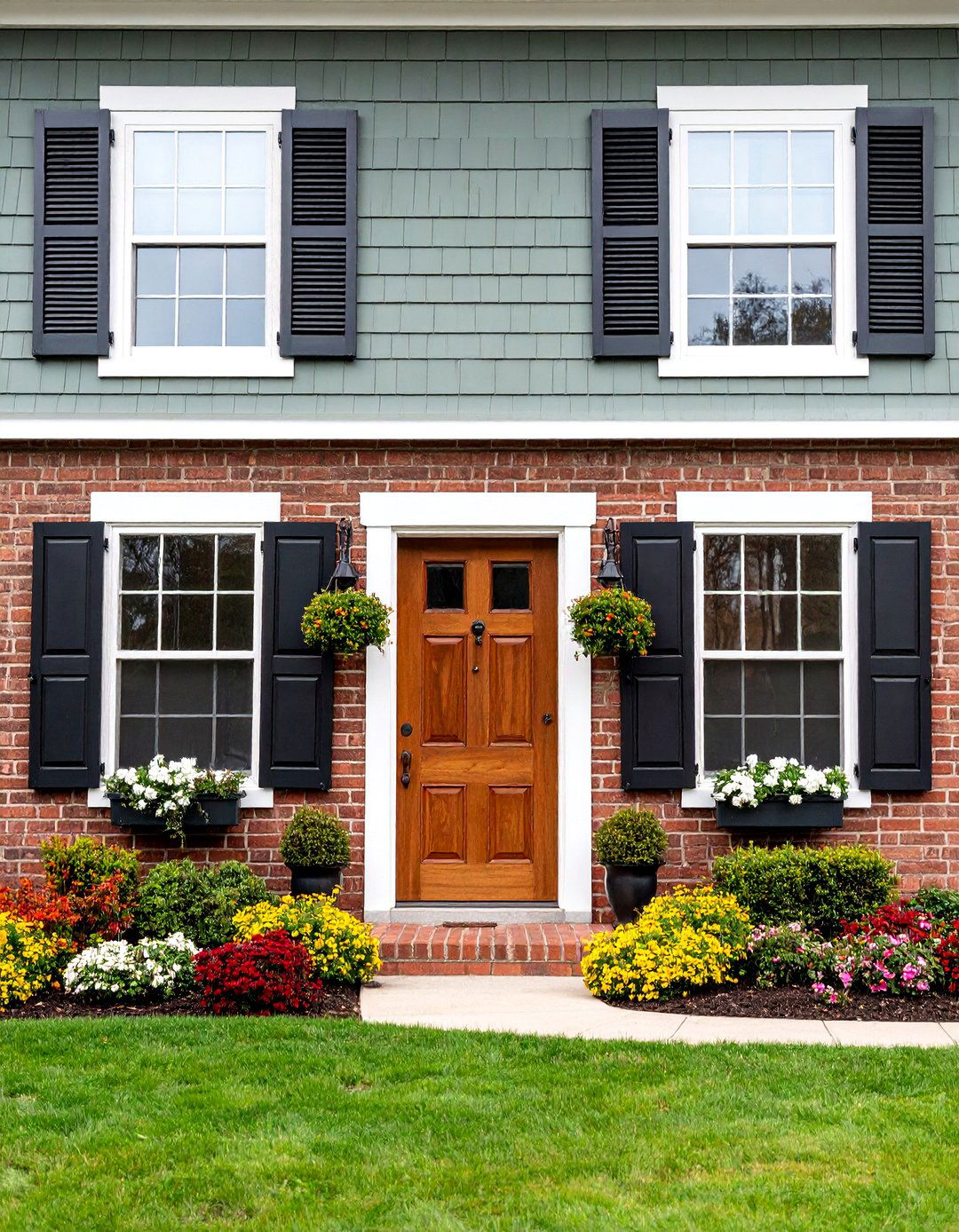
Leave a Reply